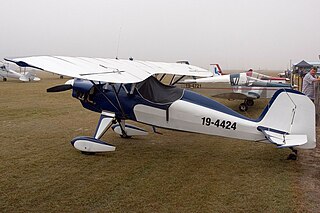
The Taylor Titch is a British fixed-wing homebuilt aircraft, developed in the 1960s by J.F. Taylor. As of 2015, examples are still being built and flown.

The Taylor J.T.1 Monoplane is a British fixed-wing aircraft design for a homebuilt aircraft, developed in the 1950s by J.F. Taylor.

The Jodel D.11 is a French two-seat monoplane designed and developed by Société Avions Jodel in response to a French government request for a low-wing aircraft for use by the nation's many emerging flying clubs.

The Luton L.A.4 Minor was a 1930s British single-seat high-wing ultra-light aircraft. The prototype was built by the Luton Aircraft Limited, and design plans were later adapted and copies sold for homebuilding.

The Brügger MB-1, MB-2 and MB-3 Colibri is a family of small sports aircraft designed in Switzerland in the 1960s and 1970s for amateur construction.
The Clutton-Tabenor Easy Too was a small homebuilt aircraft under development in the United Kingdom in the late 1970s. It was intended to be a flying showcase for designer Eric Clutton's adaptation of the Volkswagen air-cooled engine as a geared aero-engine. The lines of the aircraft were influenced by the Percival Mew Gull racer of the 1930s, but it was to have retractable undercarriage. The wings were designed to be folded to allow the aircraft to be towed behind a car.

The Sonerai is a small, VW-powered homebuilt aircraft, designed by John Monnett. The Sonerai began to compete as a single-seat, mid-wing, tailwheel Formula-V racer class formed in 1972. The Sonerai soon evolved into a two-seat model called the Sonerai II.

The Isaacs Fury is a British homebuilt sporting biplane designed by John Isaacs as a seven-tenths scale replica of the Hawker Fury fighter.

The Jurca Gnatsum is a French homebuilt near scale replica aircraft based on the North American P-51 Mustang.
The Pazmany PL-4A is a single-seat, single-engine sport aircraft developed in the United States and first flown in 1972. It is marketed for homebuilding from plans, and 686 sets had sold by 1985. The PL-4A is a conventional, low-wing cantilever monoplane with an enclosed cabin and fixed, tailwheel undercarriage. The design features a T-tail, chosen to facilitate folding the wings. Construction throughout is of metal, using standard extruded sections for the longerons and pop rivets as the basic fastener. The standard powerplant is a Volkswagen air-cooled engine of 60 hp (45 kW) Construction time is estimated to be around 1,000–1,500 hours.

The Piel CP.80 Zephir , Piel CP.801 and Piel CP.802 are racing aircraft developed in France in the 1970s and marketed for homebuilding. They are compact, single-seat, single-engine monoplanes with low, cantilever wings.
The Great Plains Aircraft Easy Eagle is a single seat homebuilt biplane, powered by a Volkswagen air-cooled engine.
The Aurore MB 04 Souris Bulle is a French ultralight aircraft, designed by Michel Barry and produced by Aurore Sarl of Sauvagnon. The aircraft is supplied as a kit or as plans for amateur construction.
The AV Leichtflugzeuge Vagabund is a German ultralight aircraft that was designed by Birk Meier, Hans Grannemann and Robert Kaps and produced by AV Leichtflugzeuge of Haren, Germany. The aircraft is supplied as a kit or plans for amateur construction or as a complete ready-to-fly-aircraft.

The Jodel D18 is a French ultralight aircraft, designed and produced by Jodel.
The Ehroflug Coach II S is a Swiss ultralight aircraft, designed by Egon Scheibe and produced by Ehroflug of Altnau. It was introduced in 1989. The aircraft is supplied as plans, as a kit for amateur construction or as a complete ready-to-fly-aircraft.
The Houde Bimax is a French ultralight aircraft, designed and produced by Patrice Houde, introduced at the Blois homebuilt aircraft fly-in in September 2010. The aircraft is supplied as a complete ready-to-fly-aircraft.

The Microleve Corsario is a Brazilian amphibious ultralight flying boat that was designed and produced by Microleve of Rio de Janeiro. The aircraft was supplied as a kit for amateur construction.

The Flitzer Z-21 or Staaken Flitzer is a British amateur-built aircraft, designed by Lynn Williams and produced by Flitzer Sportplanes of Aberdare, Wales. The aircraft is supplied as plans for amateur construction.

The Stolp SA-500 Starlet is an American amateur-built aircraft. The aircraft is supplied in the form of plans for amateur construction by Aircraft Spruce & Specialty of Corona, California.













